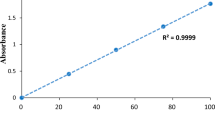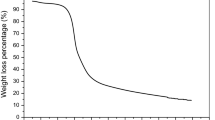Abstract
SBA-15/PAMAM Nano adsorbent was synthesized by the proficiency of SBA-15 as an original compound, 3-chloropropyltrimethoxysilane as a bridge chemical compound and polyamidoamine dendrimer (PAMAM) in the role of a multifunctional amine end group for adsorption of acid blue 62 (AB62) from aqueous media. The synthesized adsorbent was characterized by transmission electron microscope, field emission scanning electron microscope and Fourier-transform infrared spectroscope. A response surface methodology was employed to evaluate the simple and amalgamated factors of the operating variables subtending initial pH (2–12), adsorbent dosage(0.01–0.03 g), contact time (5–120 min), initial dye concentration (40–600 ppm) and temperature (25–45 °C) to optimize the operating statues of the treatment method. These parameters were altered at five levels pursuant to the central composite design to appraise their effects on AB62 removal through analysis of variance. Analysis of variance represented a high coefficient of definition amount (R2 = 0.9999) and acceptable prediction quadratic polynomial model was concluded which ascertain the suitability of the model and a high correlation among the predicted and empirical amounts. Utmost color removal efficiency was auspicated and empirically accredited. The optimum conditions relied on acquired results for AB62 removal were at an initial pH of 2, adsorbent dosage of 0.03 g SBA-15/PAMAM, dye concentration of 40 mg l−1, time contact of 60 min and temperature of 25 °C.












Similar content being viewed by others
References
Verma AK, Dash R, Bhunia P (2012) Review on chemical coagulation/flocculation technologies for removal of colour from textile wastewaters. J Environ Manage 93: 154–168
Huang CH, Chang KP, Ou HD, et.al (2011) Adsorption of cationic dyes onto mesoporous silica. Microporous Mesoporous Mater 14: 102–109
Orfao JJM, Silva AIM, Pereira JCV, et al (2006) Adsorption of a reactive dye on chemically modified activated carbons—influence of pH. J Colloid Interface Sci 296:480–489
Demirbas A (2009) Agricultural based activated carbons for the removal of dyes from aqueous solutions: a review. J Hazard Mater 167:1–9
Kannan C, Muthuraja K, Devi MR (2013) Hazardous dyes removal from aqueous solution over mesoporous alumina phosphate with textural porosity by adsorption. J Hazard Mater 10:244–245
Ngai EWT, To CKM, Ching VSM, et al (2012) Development of the conceptual model of energy and utility management in textile processing: a soft systems approach. Int J Prod Econ 135:607–617
Huang CH, Chang KP, Ou HD, et al (2011) Characterization and application of Ti-containing mesoporous silica for dye removal with synergistic effect of coupled adsorption and photo catalytic oxidation. J Hazard Mater 186:174–1182
Faria P, Orfao J, Pereira M (2004) Adsorption of anionic and cationic dyes on activated carbons with different surface chemistries. Water Res 38:2043–2052
Baskaralingam P, Pulikesi M, Ramamurthi V, et al (2006) Equilibrium studies for the adsorption of Acid dye onto modified hectorite. J Hazard Mater 136:989–992
Bechtold T, Burtscher E, Turcanu A (2001) Cathodic decolourisation of textile waste water containing reactive dyes using a multi-cathode electrolyser. J Chem Technol Biotechnol 76:303–311
Hachem C, Bocquillon F, Zahraa O, et al (2001) Decolourization of textile industry wastewater by the photocatalytic degradation process. Dyes and Pigments 49: 117–125
Papic S, Koprivanac N, Bozic AL, et al (2004) Removal of some reactive dyes from synthetic wastewater by combined Al(III) coagulation/carbon adsorption process. Dyes and Pigments 62:291–298
Mahmoodi NM (2013) Photocatalytic ozonation of dyes using multiwalled carbon nanotube. J Mol Catal A Chem 366:254–260
Ali l, Gupta VK (2006) Advances in water treatment by adsorption technology. Nat Protoc 1:2661–2667
Ali l (2010) The quest for active carbon adsorbent substitutes: inexpensive adsorbents for toxic metal ions removal from wastewater. Sepn Purif Rev 39:95–171
Ali l (2012) New generation adsorbents for water treatment. Chem Rev 112:5073–5091
Ali l (2012) Low cost adsorbents for removal of organic pollutants from wastewater. J Environ Manag 113:170–183
Ali l (2014) Water treatment by adsorption columns: evaluation at ground level. Sepn Purif Rev 43:175–205
Sadeghi-Kiakhani M, Arami M, Gharanjig K (2013) Dye removal from colored-textile wastewater using chitosan-PPI dendrimer hybrid as a biopolymer: optimization, kinetic, and isotherm studies. J Appl Polym Sci 127:2607–2619
Zarezadeh-Mehrizi M, Badiei A (2014) Highly efficient removal of basic blue 41 with nano porous silica. Water Res Ind 5:49–57
Kresge CT, Leonowicz ME, Roth WJ, et al (1992) Ordered mesoporous molecular sieves tailored using different synthesis conditions. Nature 359:710–713
Taguchi A, Schuth F (2005) Ordered mesoporous materials in catalysis. Microporous Mesoporous Mater 77:1–45
Stein A, Melde BJ, Schroden RC (2000) Hybrid inorganic-organic mesoporous silicates-nanoscopic reactors coming of age. Adv Mater 12:1403–1419
Vinu A, Hossain KZ, Ariga K (2005) Recent advances in functionalization of mesoporous silica. J Nanosci Nanotechnol 5:347–371
Blencowe A, Tan JF, Goh TK, et al (2009) Core crosslinked star polymers via controlled radical polymerization. Polymer 50:5–32
Jiang Y, Gao Q (2006) Heterogeneous hydrogenation catalyses over recyclable Pd(0) nanoparticle catalysts stabilized by PAMAM-SBA-15 organic–inorganic hybrid composites. J Am Chem Soc 128:716–717
Pisal D, Yellepeddi V, Kumar A, et al (2008) Permeability of surface-modified polyamidoamine (PAMAM) dendrimers across Caco-2 cell monolayers. Int J Pharm 350:113–121
Kovvali S, Sirkar K (2001) Dendrimer liquid membranes: CO2 separation from gas mixture. Ind Eng Chem Res 40:2502–2511
Kouketsu T, Duan S, Kai T, et al (2007) PAMAM dendrimer composite membrane for CO2 separation: formation of a chitosan gutter layer. J Membr Sci 287:51–59
Zhang W, Simanek EE (2000) Dendrimers based on melamine, divergent and orthogonal, convergent syntheses of a G3 dendrimer. Org Lett 2:843–845
Aguado J, Arsuaga JM, Arencibia A, et al (2009) Aqueous heavy metals removal by adsorption on amine-functionalized mesoporous silica. J Hazard Mater 163:213–221
Vasiliev AN, Golovko LV, Trachevsky GS, et al (2009) Adsorption of heavy metal cations by organic ligands grafted on porous materials. Microporous Mesoporous Mater 118:251–257
Zhang L, Yu C, Zhao W, et al (2007) Preparation of multiamine-grafted mesoporous silicas and their application to heavy metal ions adsorption. J Non-Cryst Solids 353:4055–4061
Jiang Y, Gao Q, Yu H, et al (2007) Intensively competitive adsorption for heavy metal ions by PAMAM-SBA-15 and EDTA–PAMAM–SBA-15 inorganic-organic hybrid materials. Microporous Mesoporous Mater 103:316–324
Bouchemal N, Azoudj Y, Merzougui Z, et al (2012) Adsorption modeling of orange G dye on mesoporous activated carbon prepared from Algerian date pits using experimental designs. Desalination Water Treat 45:284–290
Zhao D, Huo Q, Stucky G, et al (1998) Nonionic triblock and star diblock copolymer and oligomeric surfactant syntheses of highly ordered, hydrothermally stable, mesoporous silica structures. J Am Chem Soc 120:6024–6036
Bagheryan Z, Jahan-Bakhsh R, Ojani R, et al (2014) Development of a new biosensor based on functionalized SBA-15 modified screen-printed graphite electrode as a nano-reactor for Gquadruplex recognition. Talanta 119:24–38
Bhagiyalakshmi M, Yun LJ, Anuradha R, et al (2010) Utilization of rice husk ash as silica source for the synthesis of mesoporoussilicas and their application to CO2 adsorption through TREN/TEPA grafting. J Hazard Mater 175:928–938
Cheng Q, Pavlinek V, Li C, et al (2006) Synthesis and characterization of new mesoporous material with conducting polypyrrole confined in mesoporous silica. Mater Chem Phys 98:504–508
Cao J, Wu Y, Jin Y, et al (2014) Response surface methodology approach for optimization of the removal of chromium(VI) by NH2-MCM-41. J Taiwan Inst Chem Eng 45:860–868
Lim CL, Morad N, Teng TT, et al (2011) Chemical oxygen demand (COD) reduction of a reactive dye wastewater using H2O2/pyridine/Cu(II) system. Desalination Water Treat 278:26–30
Moghaddam SS, Alavi Moghaddam MR, Arami M (2011) Response surface optimization of acid red 119 dye from simulated wastewater using Al based waterworks sludge and polyaluminium chloride as coagulant. J Environ Manag 92:1284–1291
Rauf MA, Marzouki N, Körbahti BK (2008) Photolytic decolorization of Rose Bengal by UV/H2O2 and data optimization using response surface method. J Hazard Mater 159:602–609
Brereton RG (2003) Chemometrics: data analysis for the laboratory and chemical plant. Wiley, New York
Hamzeh Y, Azadeh E, Izadyar S (2011) Removal of reactive Remazol Black B from contaminated water by lignocellulose waste of canola stalks. J Color Sci Technol 5:77–85
Ho YS, McKay G (1999) Pseudo-second order model for sorption processes. Process Biochem 34:451–465
Guaracho VV, Kaminari NMS, Ponte MJJS, et al (2009) Central composite experimental design applied to removal of lead and nickel from sand. J Hazard Mater 172:1087–1092
Olmez-Hanci T, Kartal Z, Arslan-Alaton I (2012) Electrocoagulation of commercial naphthalene sulfonates: process optimization and assessment of implementation potential. J Environ Manag 99:44–51
Zhang Z, Zheng H (2009) Optimization for decolorization of azo dye acid green 20 by ultrasound and H2O2 using response surface methodology. J Hazard Mater 172:1388–1393
Kayan B, Gözmen B (2012) Degradation of Acid red 274 using H2O2 in subcritical water: application of response surface methodology. J Hazard Mater 201–202:100–106
Annadurai G (2002) Adsorption of basic dye on strongly chelating polymer: batch kinetics studies. Iran Polym J 11:237–244
Crini G, Gimbert F, Robert C, et al (2008) The removal of Basic blue 3 from aqueous solutions by chitosan-based adsorbent: batch studies. J Hazard Mater 153:96–106
Zonoozi MH, Alavi Moghaddam MR, Arami M (2008) Removal of acid red 398 dye from aqueous solutions by coagulation/flocculation process. Environ Eng Manag J 7:695–699
Chiou MS, Li HY (2003) Adsorption behavior of reactive dye in aqueous solution on chemical cross-linked chitosan beads. Chemosphere 50:1095–1105
Alley ER (2000) Water quality control handbook. McGraw-Hill, London
Yoshida H, Okamoto A, Kataoka T (1993) Adsorption of acid dye on cross-linked chitosan fibers: equilibria. Chem Eng Sci 48:2267–2272
Wang S, Ng CW, Wang W, et al (2012) A comparative study on the adsorption of acid and reactive dyes on multiwall carbon nanotubes in single and binary dye systems. J Chem Eng Data 57:1563–1569
Sun D, Zhang X, Wu Y, et al (2010) Adsorption of anionic dyes from aqueous solution on fly ash. J Hazard Mater 181:335–342
Santhi T, Manonmani S, Smitha T (2010) Removal of malachite green from aqueous solution by activated carbon prepared from the epicarp of Ricinus communis by adsorption. J Hazard Mater 179:178–186
Shirmardi M, Mesdaghinia A, Mahvi AH, et al (2012) Kinetics and equilibrium studies on adsorption of Acid Red 18 (Azo-Dye) using multiwall carbon nanotubes (MWCNTs) from aqueous solution. Euro J Chem 9:2371–2383
Wang S, Ng CW, Wang W, et al (2012) Synergistic and competitive adsorption of organic dyes on multiwalled carbon. Chem Eng J 197:34–40
Anbia M, Salehi S (2012) Removal of acid dyes from aqueous media by adsorption onto amino-functionalized nanoporous silica SBA-3. Dyes and Pigments 94:1–9
Ho KY, Mckay G, Yeung KL (2003) Selective adsorbents from ordered mesoporous silica. Langmuir 19:3019–3024
Qin Q, Ma J, Liu K (2009) Adsorption of anionic dyes on ammonium-functionalized MCM-41. J Hazard Mater 162:133–139
Author information
Authors and Affiliations
Corresponding author
Rights and permissions
About this article
Cite this article
Mirzaie, M., Rashidi, A., Tayebi, H.A. et al. Optimized Removal of Acid Blue 62 from Textile Waste Water by SBA-15/PAMAM Dendrimer Hybrid Using Response Surface Methodology. J Polym Environ 26, 1831–1843 (2018). https://doi.org/10.1007/s10924-017-1083-5
Published:
Issue Date:
DOI: https://doi.org/10.1007/s10924-017-1083-5




